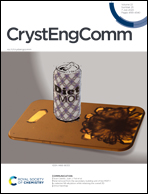Glass engineering of aminotriazine-based materials with sub-ambient Tg and high kinetic stability†
Abstract
A challenge in glass engineering is the design of molecular glasses combining a high glass kinetic stability (GS) of the amorphous phase with a low (sub-ambient) glass transition temperature (Tg). Triazine derivatives with arylamino substituents readily form glassy phases that can show outstanding resistance to crystallization. In the present study, a series of 12 analogous compounds incorporating phenylamino and cyclohexylamino groups was synthesized, and their thermal properties and intermolecular interactions were studied. All compounds possess an excellent glass-forming ability, a low Tg ranging from 32 °C to as low as −19 °C, and a high GS. While the cyclohexyl derivatives show higher Tg, the phenyl derivatives possess a higher GS with some compounds remaining completely amorphous for over three years despite their sub-ambient Tg. X-ray diffraction, infrared spectroscopy and DFT calculations reveal that the higher volume occupancy and rotational energy barrier of cyclohexyl groups are the main factors responsible for the compounds' higher Tg values but that they also contribute to their higher propensity to crystallize. In counterpart, the planarity of phenyl groups leads to poorer packing and enhances their GS while keeping their Tg well below ambient. The formation of hydrogen bonds or competing interactions provides an additional handle to tune the Tg of the compounds. Taken together, these studies provide guidelines for the design of molecular glasses with readily tunable thermal properties in view of their functionalization.



 Please wait while we load your content...
Please wait while we load your content...